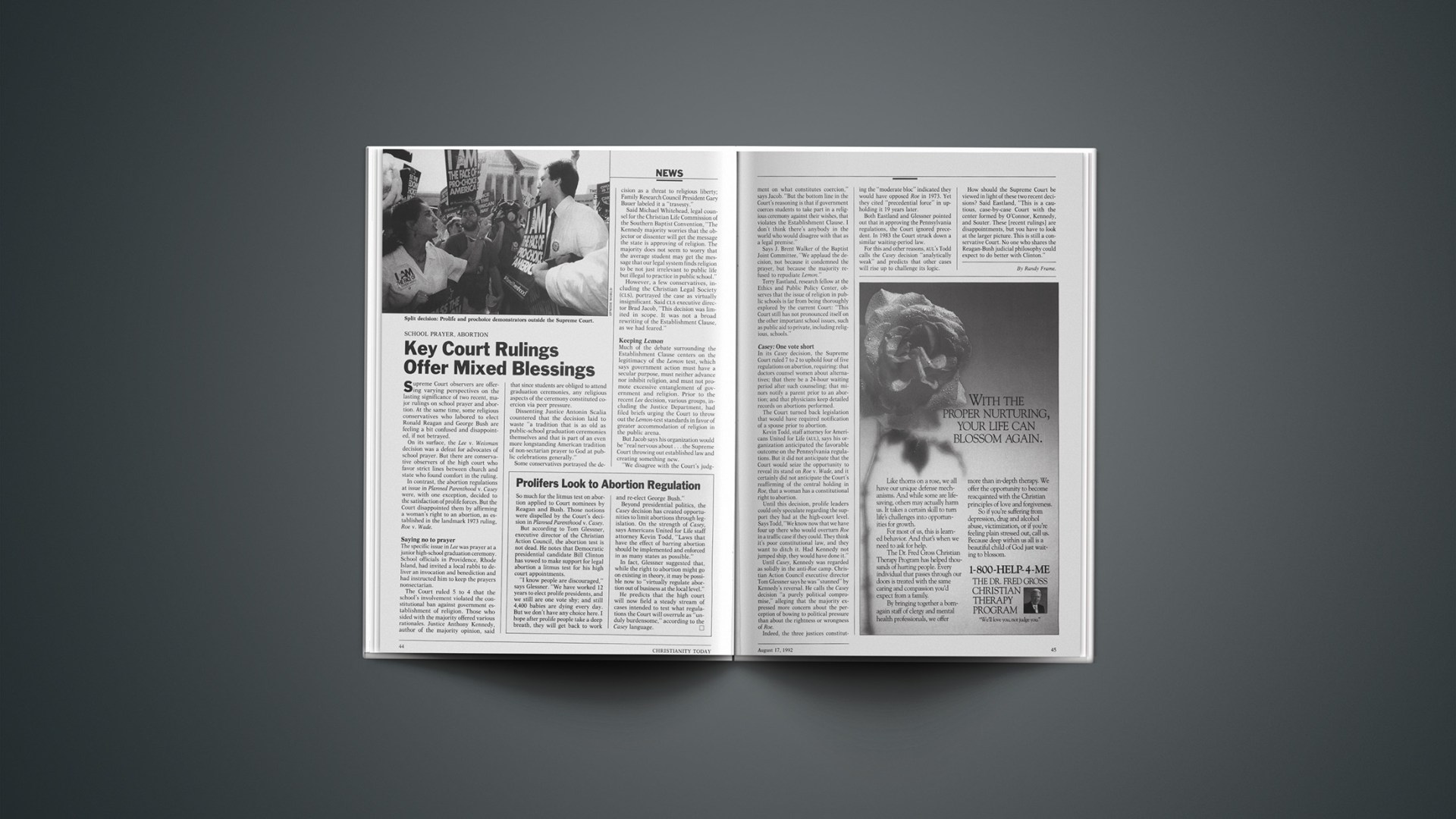Supreme Court observers are offering varying perspectives on the lasting significance of two recent, major rulings on school prayer and abortion. At the same time, some religious conservatives who labored to elect Ronald Reagan and George Bush are feeling a bit confused and disappointed, if not betrayed.
On its surface, the Lee v. Weisman decision was a defeat for advocates of school prayer. But there are conservative observers of the high court who favor strict lines between church and state who found comfort in the ruling.
In contrast, the abortion regulations at issue in Planned Parenthood v. Casey were, with one exception, decided to the satisfaction of prolife forces. But the Court disappointed them by affirming a woman’s right to an abortion, as established in the landmark 1973 ruling, Roe v. Wade.
Saying No To Prayer
The specific issue in Lee was prayer at a junior high-school graduation ceremony. School officials in Providence, Rhode Island, had invited a local rabbi to deliver an invocation and benediction and had instructed him to keep the prayers nonsectarian.
The Court ruled 5 to 4 that the school’s involvement violated the constitutional ban against government establishment of religion. Those who sided with the majority offered various rationales. Justice Anthony Kennedy, author of the majority opinion, said that since students are obliged to attend graduation ceremonies, any religious aspects of the ceremony constituted coercion via peer pressure.
Dissenting Justice Antonin Scalia countered that the decision laid to waste “a tradition that is as old as public-school graduation ceremonies themselves and that is part of an even more longstanding American tradition of non-sectarian prayer to God at public celebrations generally.”
Some conservatives portrayed the decision as a threat to religious liberty; Family Research Council President Gary Bauer labeled it a “travesty.”
Said Michael Whitehead, legal counsel for the Christian Life Commission of the Southern Baptist Convention, “The Kennedy majority worries that the objector or dissenter will get the message the state is approving of religion. The majority does not seem to worry that the average student may get the message that our legal system finds religion to be not just irrelevant to public life but illegal to practice in public school.”
However, a few conservatives, including the Christian Legal Society (CLS), portrayed the case as virtually insignificant. Said CLS executive director Brad Jacob, “This decision was limited in scope. It was not a broad rewriting of the Establishment Clause, as we had feared.”
Prolifers Look To Abortion Regulation
So much for the litmus test on abortion applied to Court nominees by Reagan and Bush. Those notions were dispelled by the Court’s decision in Planned Parenthood v. Casey.
But according to Tom Glessner, executive director of the Christian Action Council, the abortion test is not dead. He notes that Democratic presidential candidate Bill Clinton has vowed to make support for legal abortion a litmus test for his high court appointments.
“I know people are discouraged,” says Glessner. “We have worked 12 years to elect prolife presidents, and we still are one vote shy; and still 4,400 babies are dying every day. But we don’t have any choice here. I hope after prolife people take a deep breath, they will get back to work and re-elect George Bush.”
Beyond presidential politics, the Casey decision has created opportunities to limit abortions through legislation. On the strength of Casey, says Americans United for Life staff attorney Kevin Todd, “Laws that have the effect of barring abortion should be implemented and enforced in as many states as possible.”
In fact, Glessner suggested that, while the right to abortion might go on existing in theory, it may be possible now to “virtually regulate abortion out of business at the local level.”
He predicts that the high court will now field a steady stream of cases intended to test what regulations the Court will overrule as “unduly burdensome,” according to the Casey language.
Keeping Lemon
Much of the debate surrounding the Establishment Clause centers on the legitimacy of the Lemon test, which says government action must have a secular purpose, must neither advance nor inhibit religion, and must not promote excessive entanglement of government and religion. Prior to the recent Lee decision, various groups, including the Justice Department, had filed briefs urging the Court to throw out the Lemon-test standards in favor of greater accommodation of religion in the public arena.
But Jacob says his organization would be “real nervous about … the Supreme Court throwing out established law and creating something new.
“We disagree with the Court’s judgment on what constitutes coercion,” says Jacob. “But the bottom line in the Court’s reasoning is that if government coerces students to take part in a religious ceremony against their wishes, that violates the Establishment Clause. I don’t think there’s anybody in the world who would disagree with that as a legal premise.”
Says J. Brent Walker of the Baptist Joint Committee, “We applaud the decision, not because it condemned the prayer, but because the majority refused to repudiate Lemon.”
Terry Eastland, research fellow at the Ethics and Public Policy Center, observes that the issue of religion in public schools is far from being thoroughly explored by the current Court: “This Court still has not pronounced itself on the other important school issues, such as public aid to private, including religious, schools.”
Casey: One Vote Short
In its Casey decision, the Supreme Court ruled 7 to 2 to uphold four of five regulations on abortion, requiring: that doctors counsel women about alternatives; that there be a 24-hour waiting period after such counseling; that minors notify a parent prior to an abortion; and that physicians keep detailed records on abortions performed.
The Court turned back legislation that would have required notification of a spouse prior to abortion.
Kevin Todd, staff attorney for Americans United for Life (AUL), says his organization anticipated the favorable outcome on the Pennsylvania regulations. But it did not anticipate that the Court would seize the opportunity to reveal its stand on Roe v. Wade, and it certainly did not anticipate the Court’s reaffirming of the central holding in Roe, that a woman has a constitutional right to abortion.
Until this decision, prolife leaders could only speculate regarding the support they had at the high-court level. Says Todd, “We know now that we have four up there who would overturn Roe in a traffic case if they could. They think it’s poor constitutional law, and they want to ditch it. Had Kennedy not jumped ship, they would have done it.”
Until Casey, Kennedy was regarded as solidly in the anti-Roe camp. Christian Action Council executive director Tom Glessner says he was “stunned” by Kennedy’s reversal. He calls the Casey decision “a purely political compromise,” alleging that the majority expressed more concern about the perception of bowing to political pressure than about the rightness or wrongness of Roe.
Indeed, the three justices constituting the “moderate bloc” indicated they would have opposed Roe in 1973. Yet they cited “precedential force” in upholding it 19 years later.
Both Eastland and Glessner pointed out that in approving the Pennsylvania regulations, the Court ignored precedent. In 1983 the Court struck down a similar waiting-period law.
For this and other reasons, AUL’s Todd calls the Casey decision “analytically weak” and predicts that other cases will rise up to challenge its logic.
How should the Supreme Court be viewed in light of these two recent decisions? Said Eastland, “This is a cautious, case-by-case Court with the center formed by O’Connor, Kennedy, and Souter. These [recent rulings] are disappointments, but you have to look at the larger picture. This is still a conservative Court. No one who shares the Reagan-Bush judicial philosophy could expect to do better with Clinton.”
By Randy Frame.










